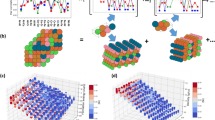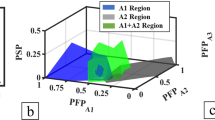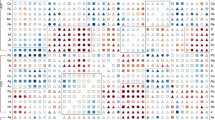Abstract
High-entropy alloys, with N elements and compositions {cν = 1,N} in competing crystal structures, have large design spaces for unique chemical and mechanical properties. Here, to enable computational design, we use a metaheuristic hybrid Cuckoo search (CS) to construct alloy configurational models on the fly that have targeted atomic site and pair probabilities on arbitrary crystal lattices, given by supercell random approximates (SCRAPs) with S sites. Our Hybrid CS permits efficient global solutions for large, discrete combinatorial optimization that scale linearly in a number of parallel processors, and linearly in sites S for SCRAPs. For example, a four-element, 128-site SCRAP is found in seconds—a more than 13,000-fold reduction over current strategies. Our method thus enables computational alloy design that is currently impractical. We qualify the models and showcase application to real alloys with targeted atomic short-range order. Being problem-agnostic, our Hybrid CS offers potential applications in diverse fields.
This is a preview of subscription content, access via your institution
Access options
Access Nature and 54 other Nature Portfolio journals
Get Nature+, our best-value online-access subscription
$29.99 / 30 days
cancel any time
Subscribe to this journal
Receive 12 digital issues and online access to articles
$99.00 per year
only $8.25 per issue
Buy this article
- Purchase on Springer Link
- Instant access to full article PDF
Prices may be subject to local taxes which are calculated during checkout






Similar content being viewed by others
Data availability
Supporting data for all data plotted in the Figs. 1–6 (as well as Supplementary Figs. 1–4) are available as source data in spreadsheets, in the Supplementary Information (see additional information) and at Code Ocean50 and https://github.com/DuaneDJohnson/Hybrid-Cuckoo-Search/. Source data are provided with this paper.
Code availability
Interactive open-source codes are available via Code Ocean for Hybrid-CS SCRAPs50 and for Hybrid CS for 1D functions51. For open-source codes (and data) for Hybrid CS SCRAPs or 1D functions, see https://github.com/DuaneDJohnson/Hybrid-Cuckoo-Search/.
References
Yeh, J. W. et al. Nanostructured high-entropy alloys with multiple principal elements: novel alloy design concepts and outcomes. Adv. Eng. Mater. 6, 299–303 (2004).
Cantor, B., Chang, I. T. H., Knight, P. & Vincent, A. J. B. Microstructural development in equiatomic multicomponent alloys. Mater. Sci. Eng. A 375–377, 213–218 (2004).
Senkov, O. N., Miller, J., Miracle, D. & Woodward, C. Accelerated exploration of multi-principal element alloys with solid solution phases. Nat. Commun. 6, 6529 (2015).
George, E. P., Raabe, D. & Ritchie, R. O. High-entropy alloys. Nat. Rev. Mater. 4, 515–534 (2019).
Gao, M.C., Yeh, J-W., Liaw, P. K., Zhang, Y. (Ed.), High-Entropy Alloys: Fundamentals and Applications, 1st ed., Springer Inter. Publishing, Switzerland, 2016, pp. 333–366.
Singh, P., Smirnov, A. V. & Johnson, D. D. Atomic short-range order and incipient long-range order in high-entropy alloys. Phys. Rev. B 91, 224204 (2015).
Singh, P. et al. Design of high-strength refractory complex solid-solution alloys. npj Comput. Mater 4, 16 (2018).
Miracle, D. B. & Senkov, O. N. A critical review of high entropy alloys and related concepts. Acta Mater. 122, 448–511 (2017).
Zhang, Y. et al. Influence of chemical disorder on energy dissipation and defect evolution in concentrated solid solution alloys. Nat. Commun. 6, 8736 (2015).
Singh, P. et al. Vacancy-mediated complex phase selection in high entropy alloys. Acta Mater. 194, 540–546 (2020).
Karati, A. et al. Ti2NiCoSnSb—a new half-Heusler type high-entropy alloy showing simultaneous increase in Seebeck coefficient and electrical conductivity for thermoelectric applications. Sci. Rep. 9, 5331 (2019).
Ding, Q. et al. Tuning element distribution, structure and properties by composition in high-entropy alloys. Nature 574, 223–227 (2019).
Li, Z., Pradeep, K. G., Deng, Y., Raabe, D. & Tasan, C. C. Metastable high-entropy dual-phase alloys overcome the strength-ductility trade-off. Nature 534, 227–230 (2016).
Zhang, R. et al. Short-range order and its impact on the CrCoNi medium-entropy alloy. Nature 581, 283–287 (2020).
Singh, P., Smirnov, A. V. & Johnson, D. D. Ta-Nb-Mo-W refractory high-entropy alloys: anomalous ordering behavior and its intriguing electronic origin. Phys. Rev. Mater. 2, 055004 (2018).
Yang, X. S. & Deb, S. Cuckoo search via Lévy flights. In Proc. World Congress on Nature and Biologically Inspired Computing 210–214 (IEEE, 2009).
Yang, X. S. & Deb, S. Engineering optimisation by Cuckoo Search. Int. J. Math. Model. Numer. Optim. 1, 330–343 (2010).
Back, T., Fogel, D. & Michalewicz, Z. Handbook of Evolutionary Computation (Oxford Univ. Press, 1996).
Yang, X. S. Engineering Optimization: An Introduction with Metaheuristic Applications (Wiley, 2010).
Yang, X. S., Koziel, S. & Leifsson, L. Computational optimization, modelling and simulation: recent trends and challenges. Procedia Comput. Sci. 18, 855–860 (2013).
Blum, C. & Roli, A. Metaheuristics in combinatorial optimization: overview and conceptual comparison. ACM Comput. Surv. 35, 268–308 (2003).
Ashlock, D. Evolutionary Computation for Modeling and Optimization 1st edn (Springer, 2016).
Kirkpatrick, S., Gelatt, C. D. Jr & Vecchi, M. P. Optimization by simulated annealing. Science 220, 671–680 (1983).
Holland, J. H. Adaptation in Natural and Artificial Systems 1st edn (MIT Press, 1992).
Kennedy, J. & Eberhart, R. Particle swarm optimization. In Proc. ICNN’95 International Conference on Neural Networks Vol. 4, 1942–1948 (IEEE, 1995).
Dorigo, M., Maniezzo, V. & Colorni, A. Ant system: optimization by a colony of cooperating agents. IEEE Trans. Syst. Man Cybern. B Cybern. 26, 29–41 (1996).
Yang, X. S. Bat algorithm for multi-objective optimisation. Int. J. Bio-Inspired Comput. 3, 267–274 (2011).
Sharma, A., Singh, R., Liaw, P. K. & Balasubramanian, G. Cuckoo searching optimal composition of multicomponent alloys by molecular simulations. Scrip. Mater. 130, 292–296 (2017).
Cowley, J. M. An approximate theory of order in alloys. Phys. Rev. 77, 669–675 (1950).
Moss, S. C. X-ray measurement of short-range order in Cu3Au. J. Appl. Phys. 35, 3547–3553 (1964).
Gutowski, M. Lévy flights as an underlying mechanism for global optimization algorithms. Preprint at https://arxiv.org/pdf/math-ph/0106003.pdf (2001).
Johnson, D. D. in Computation of Diffuse Intensities in Alloys, Characterization of Materials (ed. Kaufmann, E.) 346–375 (Wiley, 2012).
Van de Walle, A. et al. Efficient stochastic generation of special quasirandom structures. Calphad 42, 13–18 (2013).
Johnson, D. D., Nicholson, D. M., Pinski, F. J., Gyorffy, B. L. & Stocks, G. M. Density-functional theory for random alloys: total energy within the coherent-potential approximation. Phys. Rev. Lett. 56, 2088–2091 (1986).
Alam, A. & Johnson, D. D. Structural properties and stability of (meta)stable ordered, partially ordered, and disordered Al–Li alloy phases. Phys. Rev. B 85, 1441202 (2012).
Kresse, G. & Hafner, J. Ab initio molecular dynamics for liquid metals. Phys. Rev. B 47, 558–561 (1993).
Kresse, G. & Hafner, J. Ab initio molecular-dynamics simulation of the liquid–metal/amorphous–semiconductor transition in germanium. Phys. Rev. B 49, 14251–14269 (1994).
Perdew, J. P., Burke, K. & Ernzerhof, M. Generalized gradient approximation made simple. Phys. Rev. Lett. 77, 3865–3868 (1994).
Monkhorst, H. J. & Pack, J. D. Special points for Brillouin-zone integrations. Phys. Rev. B 13, 5188–5192 (1976).
Orr, R. L. Heats of formation of solid Au–Cu alloys. Acta Metall. 8, 489–493 (1960).
Flinn, P. A., McManus, G. M. & Rayne, J. A. Elastic constants of ordered and disordered Cu3Au from 4.2 to 300 °K. J. Phys. Chem. Solids 15, 189–195 (1960).
Smallmann, R. E. & Nagan, A. H. W. Modern Physical Metallurgy 3rd edn (Butterworths, 1970).
Togo, A. & Tanaka, I. First-principles phonon calculations in materials science. Scrip. Mater. 108, 1–5 (2015).
Yeh, J.-W. Alloy design strategies and future trends in high-entropy alloys. JOM 65, 1759–1771 (2013).
Sohn, S. S. et al. Ultrastrong medium-entropy single-phase alloys designed via severe lattice distortion. Adv. Mater. 31, 1807142 (2019).
Pinski, F. J. et al. Origins of compositional order in NiPt alloys. Phys. Rev. Lett. 66, 766–769 (1991).
Ceguerra, A. V. et al. Short-range order in multicomponent materials. Acta Crystallogr. A 68, 547–560 (2012).
Zunger, A., Wei, S.-H., Ferreira, L. G. & Bernard, J. E. Special quasirandom structures. Phys. Rev. Lett. 65, 353–356 (1990).
Song, H. et al. Local lattice distortion in high-entropy alloys. Phys. Rev. Mater. 1, 023404 (2017).
Singh, R., Sharma, A., Singh, P., Balasubramanian, G. & Johnson, D. D. SCRAPs: a multicomponent alloy structure design tool; https://doi.org/10.24433/CO.0000024.v1
Singh, R., Sharma, A., Singh, P., Balasubramanian, G. & Johnson, D. D. Hybrid-CS code for 1D test functions; https://doi.org/10.24433/CO.6419254.v1
Acknowledgements
R.S. was supported in part by D.D.J.’s F. Wendell Miller Professorship at ISU. Work at Ames Laboratory (by R.S., A.S., P.S. and D.D.J.) was funded by the US Department of Energy (DOE), Office of Science, Basic Energy Sciences, Materials Science & Engineering Division. Ames Laboratory is operated for the US DOE by Iowa State University under contract no. DE-AC02-07CH11358. G.B. was funded by the National Science Foundation through award no. 1944040.
Author information
Authors and Affiliations
Contributions
D.D.J. proposed and supervised the project. R.S. wrote the SCRAPs generation code using the hybrid CS algorithm. R.S. and A.S. did initial testing. D.D.J. developed the linear-scaling parallel algorithm and scaling analysis. P.S. and R.S. implemented SCRAPs optimization with parallelization and catalogged timings. P.S. completed DFT and phonon calculations, and performed analysis with D.D.J. P.S. got the code running on Code Ocean. R.S., A.S., P.S. and G.B. drafted the initial manuscript, then D.D.J. prepared the final manuscript with approval from all the authors.
Corresponding author
Ethics declarations
Competing interests
The authors declare no competing interests.
Additional information
Peer review information Fernando Chirigati was the primary editor on this Article and managed its editorial process and peer review in collaboration with the rest of the editorial team. Nature Computational Science thanks the anonymous reviewers for their contribution to the peer review of this work.
Publisher’s note Springer Nature remains neutral with regard to jurisdictional claims in published maps and institutional affiliations.
Supplementary information
Rights and permissions
About this article
Cite this article
Singh, R., Sharma, A., Singh, P. et al. Accelerating computational modeling and design of high-entropy alloys. Nat Comput Sci 1, 54–61 (2021). https://doi.org/10.1038/s43588-020-00006-7
Received:
Accepted:
Published:
Issue Date:
DOI: https://doi.org/10.1038/s43588-020-00006-7
This article is cited by
-
Continuous synthesis of high-entropy alloy nanoparticles by in-flight alloying of elemental metals
Nature Communications (2024)
-
Bayesian optimization with active learning of design constraints using an entropy-based approach
npj Computational Materials (2023)
-
Accelerating the design of compositionally complex materials via physics-informed artificial intelligence
Nature Computational Science (2023)
-
First principles-based design of lightweight high entropy alloys
Scientific Reports (2023)
-
An Experimental High-Throughput to High-Fidelity Study Towards Discovering Al–Cr Containing Corrosion-Resistant Compositionally Complex Alloys
High Entropy Alloys & Materials (2023)



